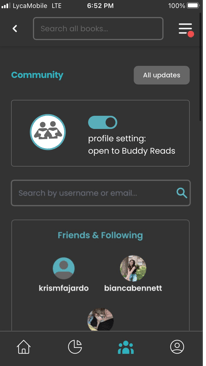

StoryGraph
StoryGraph is a book tracking platform that allows users to document the books they read, leave reviews, organize and discover titles, and connect with other readers. The target audience of StoryGraph around which their platform was built is mood readers, who read different books based on their mood and are typically interested in multiple different genres.
Timeline: Spring 2023
My role: UX/UI Design, Product Strategy
Project type: conceptual analysis of web & mobile platform
Overview
My analysis provides a framework for steering the product in the future. The platform is clearly doing an excellent job of focusing on steadily improving the key data tracking functionality of the platform, which makes sense since this is the core of the product's appeal and almost half of users' feature requests related to this aspect. However, my analysis of which requests were marked as completed shows smaller tweaks seem to be prioritized over bigger changes. Furthermore, the following aspects are important to keep in mind moving forward:
users are really craving more community features, since 13% of requests related to this demand
mobile design should be a key focus, since most users are on mobile
a slow rollout of community features, coupled with collecting user feedback and doing some user testing as more community aspects and functionality integrations are built, can be the initial phase of setting the platform apart and expanding its already user-oriented approach
I wanted to analyze trends among users' feature requests to see how it might help guide product strategy.
StoryGraph uses the Noora platform to allow subscribers to its Plus plan to submit their ideas related to tweaking or adding features. I reviewed each one of these 796 requests and categorized them according to which aspect of the platform they involved --e.g. tracking reading statistics, community features, etc. This allowed me to draw insights about what interests users most.
Goal
BIO
An avid reader who loves keeping track of what they read. Passionate about exploring new books, re-reading some favorites, and talking about books with others. A detail-oriented, creative, and cerebral person who often reads multiple books at once. Computer savvy and dedicated to tracking and developing habits around reading.
User Persona
FRUSTRATIONS
gathering statistics on personal reading can be clunky
frustrated with “black box” algorithms, lack of customizability, and poor suggestions
MOTIVATIONS
prefers reading in-depth book reviews that provide nuance
wants to build connections with other people through books
wants to see and add warnings about specific types of content
loves the opportunity to provide input directly to a product team


From reviewing all the feature requests and researching and exploring the website in-depth, I was able to put together a persona of the typical user of StoryGraph.
Key Findings
Diving into Analyzing Community Feature Requests
Users want more customizability, including in community features.
Based on which requests are labeled "Up Next", major community feature improvements don't seem to be prioritized. Instead, community aspects coming next are relatively small tweaks.
The most popular community feature additions are options for users to save/share quotes from books and to see their followers.
Many users upvoted or posted ideas related to users’ public profiles.
Shareability of different things like users' reading updates, book lists, book reviews, and reading data comes up a lot in requests.
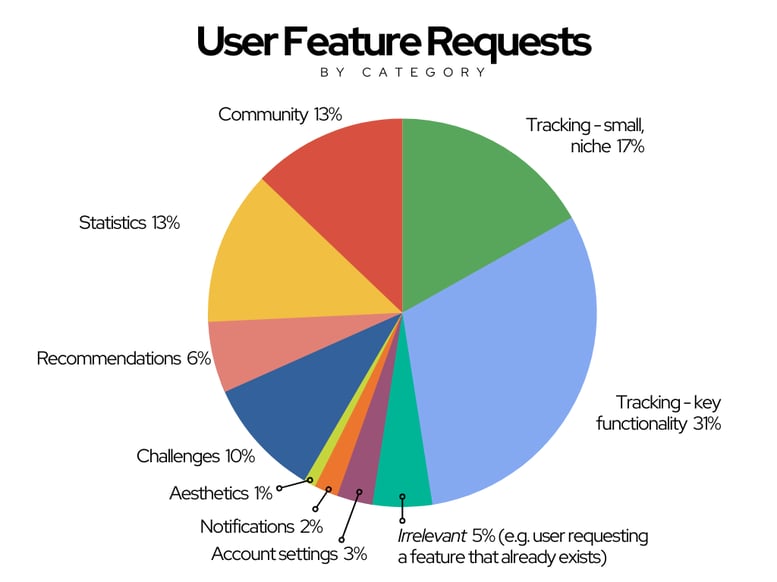

Nadia Odunayo, the site developer and founder, is very engaged with users and transparent about the product roadmap in the request threads.
A whopping 48% of requests related to the core purpose of the tool: how users track reading and how the book catalog works. These were generally categorized under "Functionality" --31% -- unless they were so specific as to fall under the "Small, niche" category, which amounted to 17% of requests.
Among the functionality-related requests, many (30%) of them relate to either how the Book Catalog works or how searching for books works. Other functionality-related requests often (12%) pertained to the User's To-Be-Read pile, often involving adding nuance to organizing planned reading, like wanting a notes section to jot down thoughts about reading the book. For both these types of requests, user testing -- especially among paid subscribers and the volunteer librarians who help update the catalog -- would be key for implementation. Being invited for beta-testing new feature additions could also be a perk of being a paid subscriber.
The conversion rate of free users to paid subscribers could be targeted more, since many of the completed requests are related to challenges and tracking, which are features accessible to both free and paid users.
13% of requests pertained to wanting improvements to community aspects on the platform, and this aspect was as popular as requests that pertained to statistics collated from users tracking their reading (another 13% of requests).
A great way to launch community features in a fairly straightforward-to-implement way would be to add a simple toggle to each user's profile: a way to express interest in being open to Buddy Reads. A Buddy Read is like a small digital book club among StoryGraph users. Users can already invite other users to join a Buddy Read, but they don't have clear signals about whether a certain user is particularly interested in joining a Buddy Read. This system would allow users to opt IN ahead of time, prompting a flag to appear on their profile indicating their interest. Other users would then be able to see, either from the user's profile screen or from the Buddy Read setup page, that that user is more likely to accept their Buddy Read request. This would reduce friction in the process. This adds a community element for use by engaged users without requiring the addition of extensive content moderation or platform integrations. (A user who hasn't opted in could still be invited to Buddy Reads, they just wouldn't be highlighted visually with the icon or prioritized algorithmically among recommendations. Later on, StoryGraph could consider letting users more explicitly opt out of being invited if users demanded this option.) User testing, and Noora discussion threads for engaged paid subscribers, would help users understand the setting.
Next, in the medium term, I would build out community even further by focusing on making things like book quotes, reading updates, and profile badges shareable. I would also build out Reading Challenge- and Reading Statistics-related shareability slowly and based on user feedback. These strategies would allow StoryGraph to enhance and highlight the unique, interactive aspects of its platform.
Community Feature Proposal


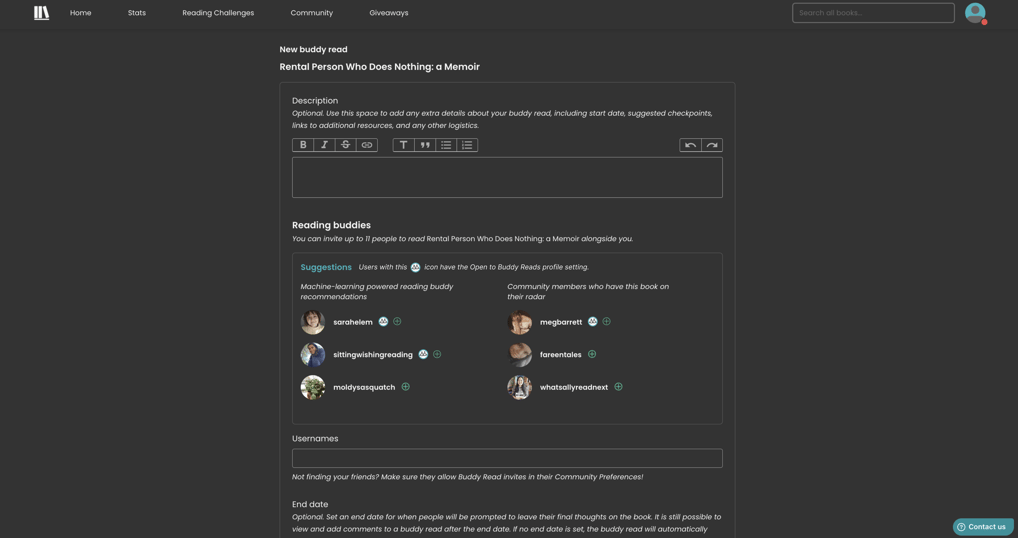

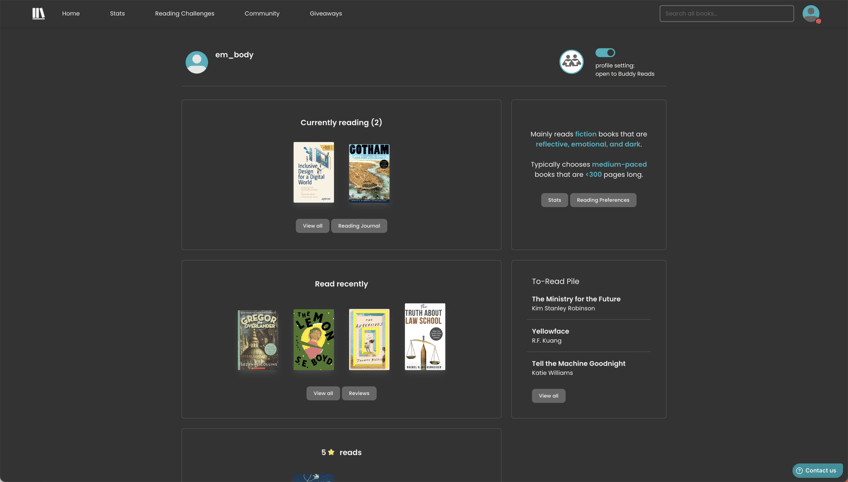

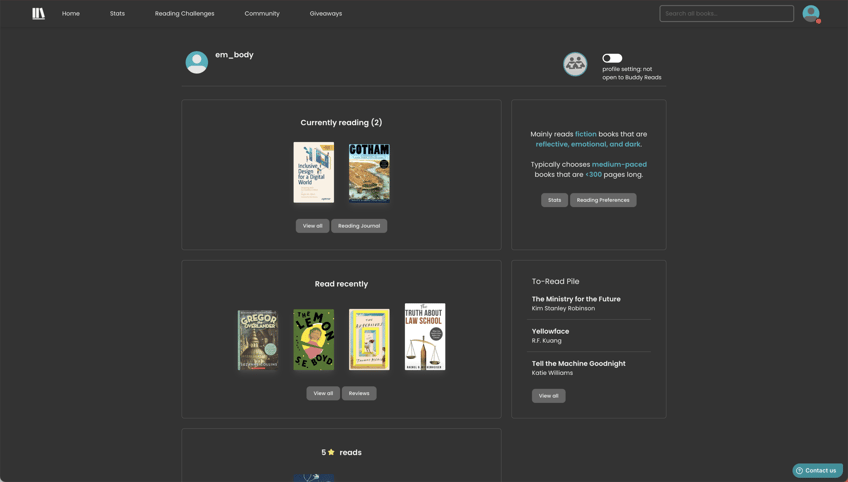

The default profile setting would be: not open to Buddy Reads
Once toggled on, user's profile indicates they are: open to Buddy Reads
In the setup screen for a new Buddy Read, users who have toggled on their Open to Buddy Read setting would have the Buddy Read icon next to their username. This would also prioritize them higher in the list of machine-learning-recommended buddies and, if applicable, in the list of community members with the particular book on their radar.
Mobile Design Emphasis
The founder and developer, Nadia Odunayo, says in a comment in one of the User Feature Request threads that most users use the platform on mobile. Thus designing for mobile should be prioritized. Also, a key thing to think about for moving forward is how to further differentiate StoryGraph from its main competitor, GoodReads, and one way StoryGraph already does that is by offering a more dedicated Community tab on mobile, therefore making the community aspect of the experience discoverable while also being a curated, segmented part of the app. This tab could be enhanced with the addition of the Open to Buddy Reads toggle, which invites the user to consider how they might want to engage with other users right upfront.
Thinking deeply about larger goals and going thorough user testing and multiple design iterations will be important in making these decisions.
StoryGraph (mock-up)
GoodReads
(competitor)





